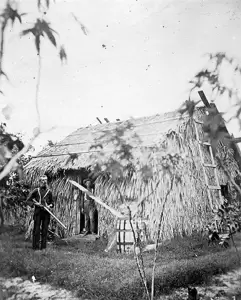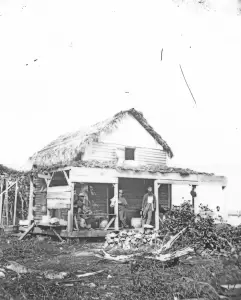Treasure Hunting
The pioneers used whatever they could find to build and furnish their homes—local trees, driftwood, and even lumber from shipwrecks. One thing they had was plenty of palmetto to make their homes.
Louis W. Burkhardt brought his family to Lake Worth in 1893 to join his brother, Henry, and to improve his wife, Eva’s, health. The Burkhardts’ first home, in Lantana, was a 20-x-30-foot shack with a wood floor, three walls of canvas, and a thatched roof of palmetto leaves, which the Seminoles taught them to make. Before long, Eva Burkhardt was chopping wood. Louis’ son, named for his uncle Henry Burkhardt II, later said in an 1962 interview, that it was “those early days of cooking out, under an umbrella at times, that helped to bring back her health. Just wood fires in the early days, until we was able to get a stove later, ‘cause everything was so primitive down here.”
Thatched roofs were common on the first houses and provided a perfect refuge for roaches, snakes, and lizards, as Lillie Voss recalled: “When new, these shacks are pleasant shelters with the fresh odor of the newly cut leaves and are rather pretty, light green in color and clean … but an old one is brown, leaky, and full of roaches.”
There were many shipwrecks along the southeast Florida coast in the 19th century, which Charlie Pierce blamed on the inshore current: “Particularly sailing vessels, it really sent them ashore.”
Lillie Voss’ son, Gilbert, described his grandparents’ 1874 home in an article for Tequesta (1968):
The Pierce house was built of heavy ship's timbers for corner posts, the siding from ship's planking, all gathered from the beach; the shingles were rived on the beach from ranging timbers and smoothed down by hand with a drawshave. The ceiling came from the nearest saw mill at Daytona Beach from timber carried up by boat, milled and returned, a round trip of about three or four weeks.
Gilbert Voss
The Pierce house is still in use as an outbuilding on the estate it became part of.
The settlers scoured shipwrecks not only for wood, but also for pots and pans, wood-burning stoves, food, and other amenities to make life easier. Marjorie Potter Stewart: “When wrecks came ashore during the hurricanes, they’d get everything they could off. I have china in the china cabinet in Mother’s house now that came off of one of them.” Gilbert Voss wrote in Tequesta (1968), “Lumber was salvaged, barrels of food, cans of butter, kegs of wine, olives packed in oil; all found their way to the beach eventually.”
Marion Dimick Geer missed out on a lucrative hurricane before her arrival in 1876:
Charlie Moore told us everything from pine and needles to a sawmill came, including a large amount of money and a fine cook stove (in spite of the fact that iron will sink). Trunks containing ladies’ clothing, too—and Mr. Moore assured us he wore trimmed underclothes for some time, having no wife.
Marion Dimick Geer



